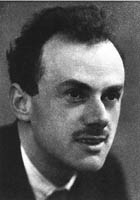Dirac, Paul Adrien Maurice
Paul Adrien Maurice Dirac (1902-1984), a Swiss physicist, was awarded the Nobel Prize for Physics in 1933 for his many vital contributions to quantum mechanics, the theory that describes the world on a very small scale. Dirac's theory included wave mechanics (the version of quantum mechanics developed by Schrödinger), and matrix mechanics (the theory put forward by Heisenberg). In 1928, he published what is now known as the Dirac equation that explains the magnetic and "spin" properties of the electron. In 1931, Dirac used his equation to predict the existence of a particle with the same mass as the electron but with a positive rather than a negative charge. This "anti-particle," now called a positron, was actually detected in 1932. All particles are now known to have anti-particles.
Further Reading
Paul A. M. Dirac - Biography (Nobel Foundation)
Paul Adrien Maurice Dirac (Institute of Physics)
